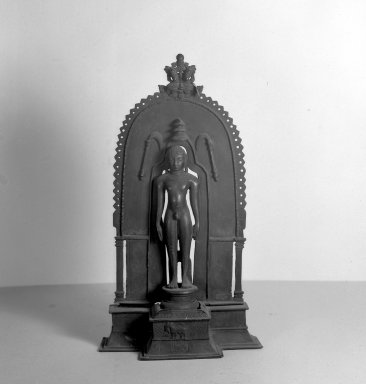
Medium: Brass
Geograhical Locations:
Dates:17th–18th century
Dimensions: 14 3/4 x 3 15/16 x 7 7/8 in. (37.5 x 10 x 20 cm)
Collections:
Accession Number: 34.738
Image: 34.738_acetate_bw.jpg,
Catalogue Description: Small standing brass image of the seventeenth Jina, Kunthu, standing on a low circular pedestal (pitha) which in turn rests on a large base, and with an arched screen (torana) behind. The figure is completely nude, and hence belongs to the Digambara sect. His hair is in curls, he has long earlobes, and stands in a rigid pose, with arms pendant. The torana consists of a flat sheet of brass, rounded at the top and cut out behind the figure. At the base of either side are 2 low columns, partially cut out. Above the figure is a small, 3-tiered canopy (chattra), and on either side are fly whisks in relief. The edge of the torana is scalloped and pierced and at the top, in high relief, is a grotesque head called a kirtimukha. The base on which both image and torana rest is rectangular, spreading at the bottom, and with a slightly projecting upper edge. There is a wide projection in the center for the image. On the front of this is a small goat, in high relief, the cognizance (identifying animal emblem) of the Jina. On either side are areas with engraved criss-cross patterns, and below similarly engraved, widely-spaced designs, probably crude representations of lotus petals. There is a low railing around the top of the projection, which leans inwards and partially covers the circular stand on which the figure rests. On the top of the base inside this railing, and partially covered by the figure, is an engraved, circular lotus mark. At the base of the torana are smaller lotus designs, the center one in a circle and the other ones in lozenges. The brass is blackened.